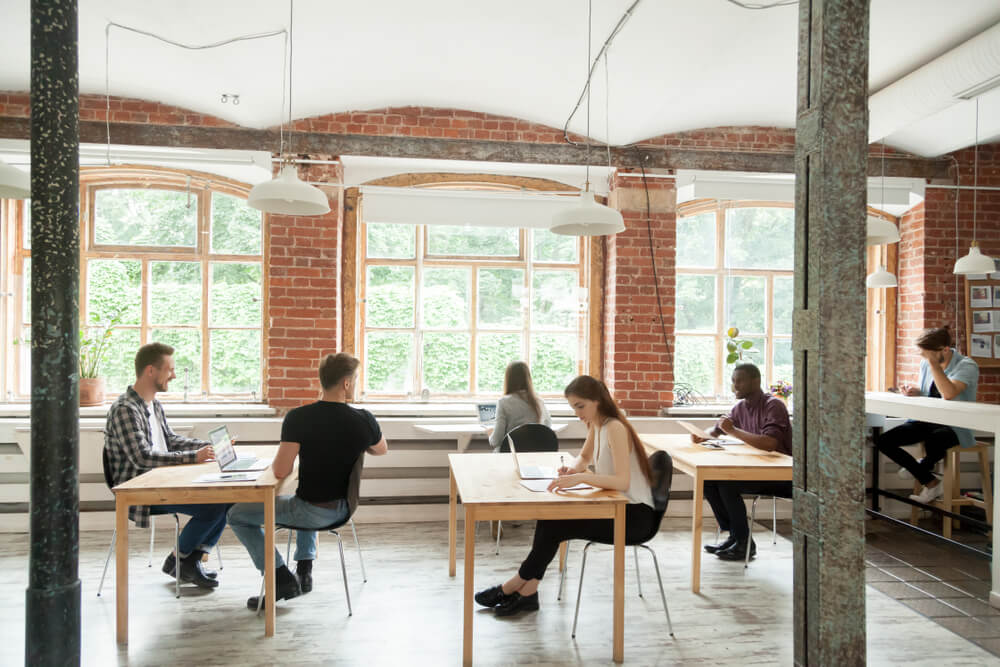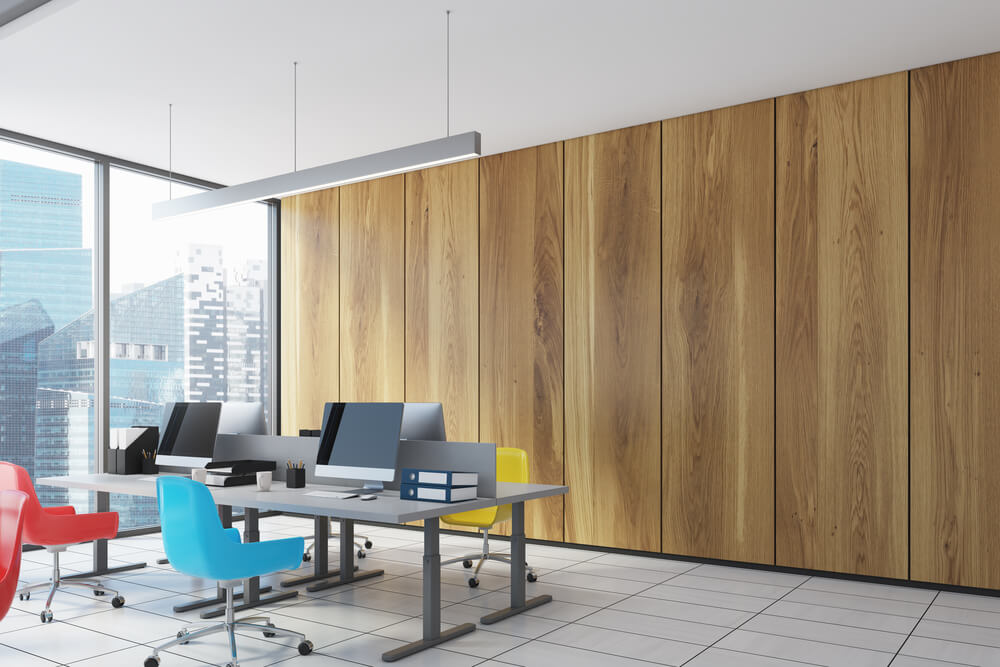If you run an office, rent an office space, or are a freelancer taking advantage of a coworking space, you have probably come across the term hot desking at one time or another.
But what is it exactly?
What is the difference between it and hoteling or flexible working? What are its benefits and possible disadvantages? How can you apply it to your own office space?
We’ll try to answer all of these questions and help you uncover how hot desking can revolutionize your business in the meantime.
So, What’s Hot Desking?

Hot desking is a term that first became popular during the 1990s. Essentially, it means that employees do not have their assigned work station but can take up any empty space at a work table. This kind of office space operates on a first-come, first-served basis. It eliminates the need for cubicles and other markers of a traditional work space.
The name itself is derived from the term hot racking, which is used in sailing. Sailors take different shifts working (and sleeping), so they do not have their own assigned bunk. Hot racking is what they call sharing bunks in this way.
Another name often used instead of hot desking is hoteling, though they are not entirely interchangeable. Hoteling requires staff to reserve a space before using it. So make sure you are clear when making plans within your office in case there is any space for a misunderstanding to arise.
It is also one of the techniques that can be implemented to ensure having well managed office spaces. There would still be no assigned seating, but employees would have the option of reserving a work station, a conference room, or whatever else is available according to their needs.
Finally, flexible working is an umbrella term for different kinds of shared work spaces, flexible working hours, and other markers of untraditional working organization. Hot desking and hoteling fall under it, as do other options employers can offer their employees – flexible hours, remote working, etc. All the good stuff employees now expect from a modern workplace.
How is Hot Desking Revolutionizing Business?
Even though the initial concept appeared in the 1990s, it has been gaining popularity more recently.
For one, the digitization of the workplace has played a major part in it. It is much easier to put hot desking into action now than it was years ago, when paper still reigned supreme, and employees needed extra space for things like memos and filing cabinets.
Forgoing traditional office layouts makes more sense in contemporary workplaces. If your company offers employees the options of remote working and/or flexible working hours, the wish to eliminate unused space is completely understandable. Its promise of increased productivity and team spirit, among other perks, makes it one of the most desirable layouts for anyone planning to lease office space.
The rise in the popularity of coworking office space is also what contributed to companies implementing hot desking policies. Hot desking provides workers with a functioning work station aimed towards efficiency while simultaneously making work feel less isolating and more conducive to building lasting and productive relationships.
With its rising popularity, it is obvious that hot desking holds many advantages.
Hot Desking is Cost-Effective and Increases Efficiency

The primary benefits of hot desking are the financial savings resulting from saving space.
According to some sources, companies can reduce the cost of office rental by up to 30 percent. Anyone looking into office rental in Ventura, for example, knows how difficult it is to find affordable office space in urban centers with high prices of real estate. Why would a company dole out large sums of money on real estate, hurting its profit margins, if a lot of that space remains unused?
Hot desking forces offices to function at maximum efficiency. Due to absences, flexible working hours, and back-to-back meetings, a large portion of office space routinely goes unused. Often, companies that decide to implement hot desking in their office space use it as a benign but effective cost-reducing measure. The rent is an expense that can really harm a company’s bottom line, so jumping at the opportunity to reduce it can really help with profitability.
Hot Desking Improves Teamwork
Another benefit of hot desking is that this kind of organization inspires a more interactive office space. People are moved to mingle and talk to their coworkers more.
According to the Wall Street Journal, 40 to 60 percent of an employee’s daily interactions are with their office neighbors. If there is no assigned seating, the chances are that employees will be moved to communicate with a variety of different people from numerous different departments. Very often, this will include people they would otherwise never even meet.
Furthermore, hot desking provides ample opportunities for teamwork and easier organization of group or department projects. Instead of reserving a conference room or having endless back-to-back meetings, a group can simply huddle together for the duration of their project.
All this makes for a more dynamic and, in many cases, a more productive office environment. It also makes the office a more collaborative working space, adding a necessary social aspect to the workday.
Oxford Economics studied the impacts of a communal working space and found that this was a particularly important benefit in the eyes of the employees. Being exposed to people from different departments made employees feel like an important piece in a big puzzle.
Hot Desking Helps Workers Break Out of a Rut
Though routines do not necessarily have to be negative, they can often cause work to suffer.
Going into the same cubicle or office day after day and seeing the same people around the water cooler can slow down even the most efficient employee.
On the other hand, working in a hot desking office keeps things fresh by the sheer virtue of working in a different area surrounded by different coworkers every day. It keeps employees on their toes and makes every day interesting.
Hot Desking Helps Declutter Space and Mind

There have long been reports of the harmful effects clutter can have on our mental health. At the very least, clutter causes increased levels of life dissatisfaction, and can even contribute to the conditions of anxiety and depression.
In an office environment, it can be particularly harmful as it is known to increase the levels of cortisol – the stress hormone.
And a stressed worker is usually not the most efficient worker, right?
Hot desking completely eliminates clutter at work. Not having your own work station ensures that you leave no trace behind once the clock strikes five. It also means coming to a clean work table and office space, primed for a productive day.
Additional Things to Consider Concerning Hot Desking
Unfortunately, hot desking perks do not come without their disadvantages.
While it is a legitimate way of saving space, it might not be possible to implement it successfully in all offices.
If you are considering hot desking as a way of improving your business’ efficiency, there are some points to consider if you want the office space model to go without a hitch.
Hot Desking Can Be Stressful
For starters, not having your own desk, office, or work station means having to look for one every morning when you come in. This does not seem like too much of a problem until you learn that people waste 18 minutes a day on average by searching for a place to work.
Besides wasting time, going through this day after day can contribute to the stress levels for employees before the working day has even started.
Not only is it an early morning obstacle, but it can also turn employees against each other in their struggle to get what they deem is a prime spot within their co-shared office space. People who have to drop their kids off at school before work, for example, will be at a disadvantage compared to people without such responsibilities.
With hot desking, you have to make sure not to add on to the stress of your employees, which can lead to employee burnout. So, it would be good to implement some rules beforehand. Just in case.
In Some Cases, Hot Desking Can Hurt Productivity

Hot desking can prove to be troublesome when it comes to doing work quickly and efficiently as well. As there is no assigned seating, employees can find it difficult to find the people they are supposed to be talking to or collaborating with on different projects.
It can also be hard to build a spirit of teamwork within a large company if every person feels as if they spend their days sitting next to an endless conveyor belt of other employees. So even though its aim is the complete opposite, hot desking can become pretty isolating if done wrong.
There’s No Privacy with Hot Desking
Coworking offices that adhere entirely to the hot desking philosophy could be hurt by its lack of privacy.
Reports suggest that a lack of visual privacy can affect the employees’ concentration. Additionally, if you are in need of a spot to have a confidential conversation, you will be hard-pressed to find it.
Different Levels of Comfort Might Not Be Addressed
Finally, not having your own designated work station can spell trouble for your body too. People with different musculoskeletal conditions cannot know for sure if an ergonomic or standing desk will be available for them every day.
Besides that, sharing indiscriminately can be tricky when it comes to contagious diseases too. A Bloomberg article in particular sites why hot desking in the age of the coronavirus might be a bad idea.
How to Manage Hot Desking
As is evident from the aforementioned disadvantages of hot desking, certain aspects of it may need to be remedied if they prove to be a problem. Here are some of the potential issues you may want to address.
Practicality
The main idea of hot desking is flexibility for employees and the increased functionality of the communal working space. If you notice productivity slipping or your employees report feeling distracted, you may want to introduce some boundaries.
For example, some people need a lot of peace and quiet to do their best work, while others thrive in a noisy, dynamic environment. If you notice these two types of employees clashing, you can try designating different office areas for quiet work. That way, the employees will still have a lot of freedom without feeling overwhelmed or distracted.
IT

One of your company’s departments that might curse the day hot desking became your favored option is your IT department.
Ensuring your entire office space has all of the technology necessary to be efficient and productive can quickly turn into a waking nightmare.
The same is true for offices that disregard this aspect of their new layout. Our increasing dependence on technology is one of the first things employers and office managers need to consider when implementing hot desking.
Employee Progress
To ensure hot desking is working out well, it is not just important to notice an increase in your budget from all the money you saved on space. It is also important to ensure this major change is not making a negative impact on productivity. The only way to do this is by tracking employee progress.
Even though there is a lot of freedom when it comes to choosing their working station for the day, your employees still need to know what is expected of them and who they answer to. Setting clear goals for them and checking their progress is the best way to ensure they are able to do their best work.
Accountability Partners
With employees so broadly dispersed, it can be difficult for managers to keep track of everyone on a daily basis. One of the ways of remedying that is by instating accountability partners.
This should in no way be seen as an invitation for the employees to complain about one another. Rather, you should pair up people who are likely to have a productive symbiotic professional relationship, which will keep them both on the right track.
Flexibility and Focus
Finally, employers will want to keep an open ear towards how their employees feel once hot desking is implemented.
This way of office space organization opens the doors wide to different types of flexibility that employees usually respond positively to. Working from home several days of the week or introducing flexible working hours in tandem with hot desking could do wonders for your company’s productivity. It is important not to lose sight of that key goal.
